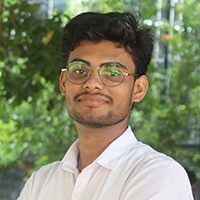Member's Voice

-
- Shilagani Shivaprasad
- Current Affiliation :
SR UNIVERSITY - Country/Region :
India - Name : Shilagani Shivaprasad
I am Shivaprasad Shilagani, and I am thrilled to share my incredible journey as part of the Sakura Science Exchange Program, funded by JST Japan. This program provided me with unparalleled opportunities to explore cutting-edge research, engage with esteemed professors, and immerse myself in the rich academic and cultural environment of Japan.
At the Higashi-Hiroshima Observatory, I had the privilege of learning from Prof. Koji Kawabata about advanced astronomical research and technology. I observed the Orion Nebula using optical and near-infrared wavelengths and compared HgCdTe (USA) and InGaAs (Japan) image sensor arrays for infrared astronomy. Additionally, I explored the Kanata 1.5-m Telescope and its imaging capabilities while gaining insights into Gamma-Ray Burst (GRB) studies, including GRB polarization and the role of VLSI technology in handling large datasets. This experience deepened my understanding of astronomical technologies and their applications, and I am deeply grateful to Prof. Kawabata for his guidance and mentorship.
At the Kyoto University Observatory, I explored the 1.88m and Seimei 3.8m Telescopes, gaining insights into their advanced observation capabilities. The Astronomical Museum showcased the evolution of telescopic technology, which was fascinating. I also had the opportunity to interact with Prof. Abhradeep Roy, a postdoctoral researcher, who shared insights on the role of silicon in astronomy, particularly in image sensors and semiconductor devices. He also discussed the emission mechanisms of pulsars, X-rays, and galaxies and the importance of silicon photomultipliers for gamma-ray detection. This visit expanded my knowledge of astronomical technology and its interdisciplinary applications.
At the Research Institute for Semiconductor Engineering (RISE) at Hiroshima University, I delved into cutting-edge semiconductor research under the guidance of Prof. Masataka Miyake and Dr. Sandip Bhattacharya. I explored advanced semiconductor technologies and innovations, learned about the future of wireless communication networks and nanodevices, and engaged in cultural and academic exchanges with Hiroshima University students. These interactions provided a deeper understanding of both Indian and Japanese educational systems. This visit was a perfect blend of academic learning and cultural immersion, and I am grateful to the RISE team and Hiroshima University for their hospitality.
A standout moment of the program was my visit to Micron Technology Fab 15 in Hiroshima. Guided by Seiji Tanaka, Director of Fab 15, and Ravi Yadav, Extreme Guider, I gained invaluable insights into the semiconductor manufacturing process. This experience was made possible by the support of Prof. Masataka Miyake and the mentorship of Dr. Sandip Bhattacharya and Subhajit Das Sir, whose encouragement continues to inspire me.
The program concluded with a memorable presentation, where I shared my experiences and insights alongside my fellow students. I am deeply grateful to Prof. Koji Kawabata and Prof. Masataka Miyake for their guidance throughout the program. Receiving the Sakura Science Exchange Program Certificate was a proud moment, symbolizing the hard work, learning, and growth achieved during this exceptional journey.
This program has been a transformative experience, allowing me to gain hands-on knowledge in astronomy, semiconductor engineering, and advanced technologies. I built meaningful connections with professors, researchers, and students from Japan and immersed myself in the rich culture and academic environment of Japan. I extend my heartfelt gratitude to Prof. Koji Kawabata and Prof. Masataka Miyake for their mentorship, Dr. Sandip Bhattacharya and Subhajit Das Sir for their unwavering support, and the Sakura Science Exchange Program and JST Japan for this incredible opportunity.
The Sakura Science Exchange Program has been a milestone in my academic and personal growth. It has reinforced my belief in the power of international collaboration and the importance of pushing the boundaries of knowledge. I am excited to carry forward the lessons learned and contribute to the global scientific community.







